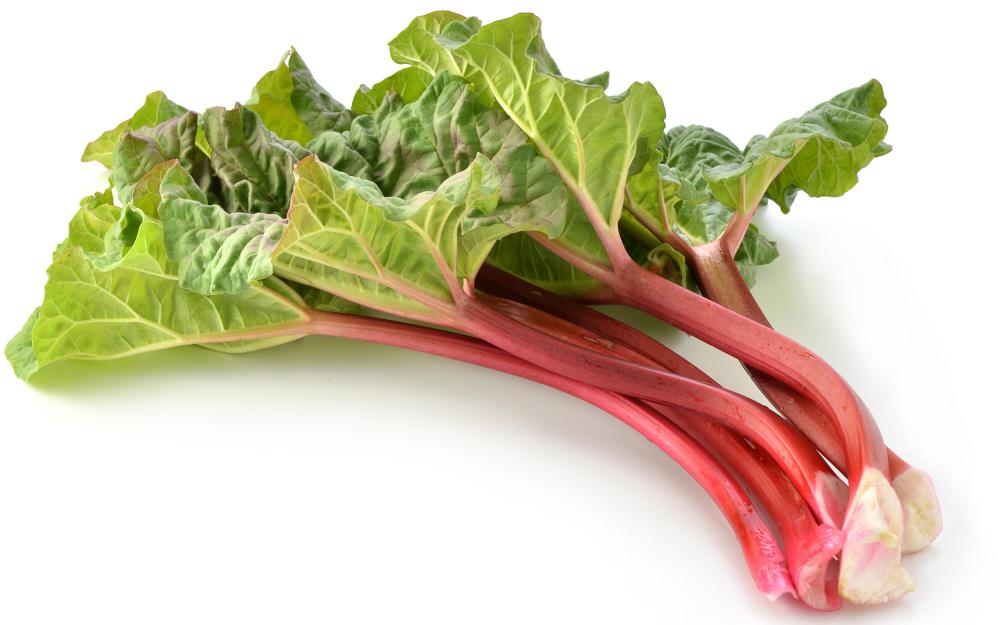At AllThingsNature, we're committed to delivering accurate, trustworthy information. Our expert-authored content is rigorously fact-checked and sourced from credible authorities. Discover how we uphold the highest standards in providing you with reliable knowledge.
What are Rhubarb Crowns?
Rhubarb crowns are the portions of a rhubarb plant located under the ground's surface that consist of rhizomes and buds. The plant spreads and grows via the rhubarb crowns, and new plants can be propagated by dividing them. Unlike the reddish stems that grow from them, the crown and leaves of the plant are not edible. Maintaining healthy crowns is vital for the production of a strong harvest. Rhubarb is a hardy plant that can be grown in vegetable gardens with relative ease; it can be afflicted with crown rot, however, which is very damaging to the plant.
When considered as part of the whole, rhubarb crowns are extremely important to a plant's overall health even though they are located underground. They function as roots, drawing nutrients and water from the soil. They consist of fleshy rhizomes, which are spreading horizontal stems, and areas of new growth known as buds. They are responsible for the rhubarb's spread and growth, and any damage to the crown can have adverse effects on the entire plant.

Rhubarb is usually not planted from seeds; whole or divided rhubarb crowns are purchased from a nursery, garden center, or catalog and then planted. When planting the crown, the soil should be prepared by loosening it and mixing in compost or manure along with a small amount of fertilizer high in phosphorus and potassium. The rhubarb crown should be placed in the soil approximately 1 to 2 inches (2.5 to 5 cm) deep for the best results. Once the plant has sprouted and has some growth above ground, a layer of mulching material can be added to help preserve moisture and prevent weeds.
Rhubarb crowns can be used to propagate the plant by division. It's best to do this when the rhubarb plant is about six to 10 years old in the very early spring. The crown can be dug up while the plant is dormant and divided into pieces the size of a fist; each one should have a large root portion and at least one bud. Once the new plant starts to develop, it's advisable to wait at least a year before harvesting the edible leaf stalks, and to pick them sparingly the second year.
The maintenance of the rhubarb crowns in a healthy state is important for the strength of the whole plant. Strong crowns produce bigger harvests and allow the plant to spread in a more vigorous manner. Rhubarb is normally a hardy plant that grows well with minimal care in cooler temperate areas. It occasionally develops crown rot from Phytophthora fungus, which usually kills the plant since it doesn't respond to antifungal agents. The best treatment is prevention by planting rhubarb crowns obtained from reputable sources in well drained soil.
Frequently Asked Questions
What exactly is a rhubarb crown?
A rhubarb crown is the perennial root system of the rhubarb plant, consisting of the upper part of the root and the buds from which the plant's stems and leaves emerge. It's a hardy structure that can survive through winter and produce new growth each spring, making it the life center of the rhubarb plant.
How do you plant a rhubarb crown?
To plant a rhubarb crown, dig a spacious hole in well-drained, fertile soil, enriched with compost or manure. Set the crown so that the top of the root is just below the surface. Space crowns about 75 cm apart to allow for growth and ensure the soil is moist but not waterlogged to encourage healthy development.
When is the best time to plant rhubarb crowns?
The ideal time to plant rhubarb crowns is in the early spring or late autumn. This timing allows the crowns to establish themselves during cooler weather, which is less stressful for the plant. Planting during these seasons ensures that the crowns will have a strong start for vigorous growth when the temperatures rise.
Can you divide rhubarb crowns?
Yes, dividing rhubarb crowns is a common practice to propagate the plant. It's best done when the plant is dormant, typically in early spring before growth starts or in the fall after the leaves have died back. Carefully lift the entire plant, and use a sharp spade or knife to divide the crown into sections, each with at least one bud.
How long does it take for a rhubarb crown to produce edible stalks?
After planting a rhubarb crown, it typically takes about two years for the plant to establish itself and produce stalks that are ready for harvest. It's recommended to avoid harvesting in the first year to allow the plant to grow strong roots and foliage, which will support more vigorous production in subsequent years.
Are rhubarb crowns susceptible to any diseases or pests?
Rhubarb crowns can be susceptible to various diseases and pests, such as crown rot, which is often caused by poor drainage and can be mitigated by ensuring good soil conditions. Rhubarb can also be affected by pests like rhubarb curculio and slugs. Regular monitoring and maintaining healthy soil can help prevent these issues.
AS FEATURED ON:
AS FEATURED ON:











Discuss this Article
Post your comments